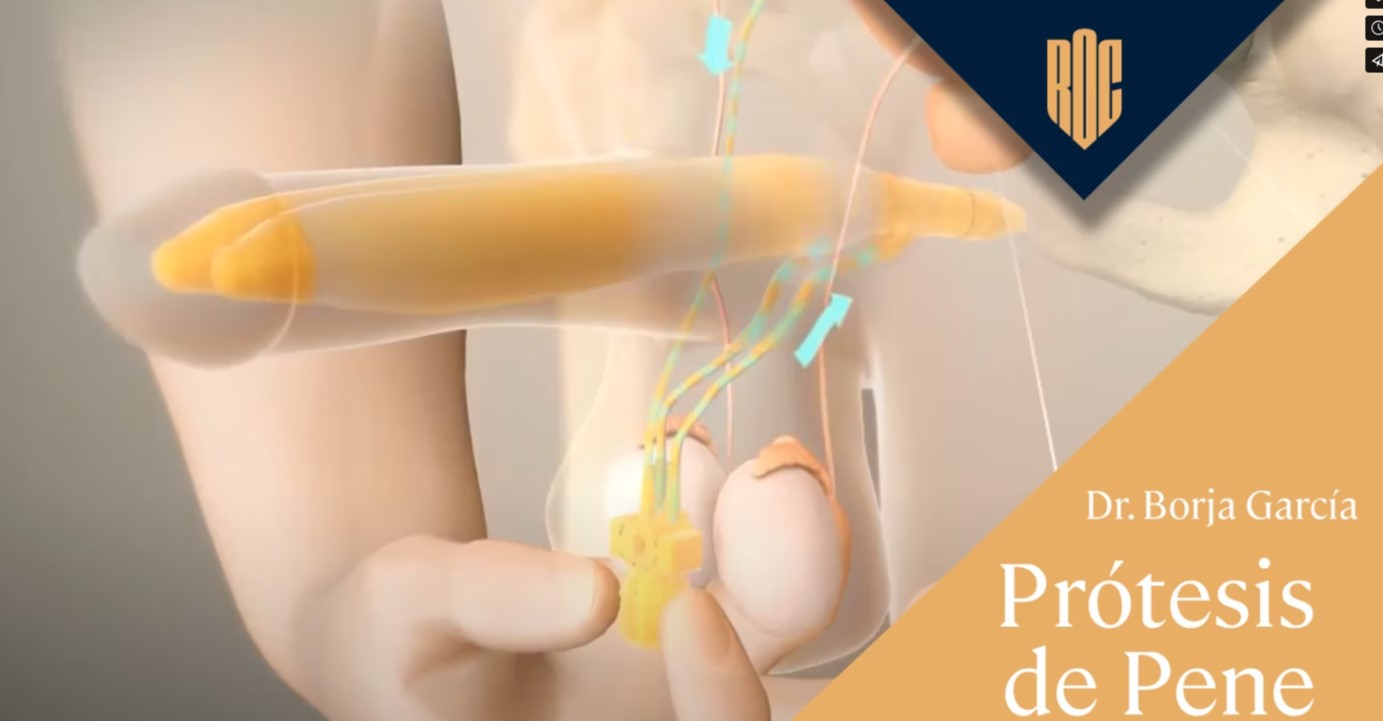Penile Prosthesis
A penile prosthesis is a device that is implanted inside the penis to give it the ability to achieve erection. It is a solution for erectile dysfunction.


- Super-specialized urologists
- Personalized treatment
- Minimally invasive approach
- More than 10,000 patients successfully treated
What is a penile prosthesis?
A penile prosthesis is a mechanical device that is implanted inside the penis in order to give it the ability to achieve erection and maintain rigidity to maintain sexual intercourse with penetration.
This device is composed of two cylinders that are placed inside the corpora cavernosa and perform the function of these to achieve the state of erection. A surgical intervention is necessary for its implantation.
When to implant a penile prosthesis?
Among all the existing treatments for erectile dysfunction, penile prosthesis is the one with the best satisfaction rates. However, because once implanted it is not possible to resume other treatments, it is the last of the therapeutic options.
Penile implants are usually used when other more conservative treatments such as medication, shock waves or intracavernous injections have not worked, or when the patient wants a definitive solution.
Types of penile prosthesis
There are two types of penile prostheses and it is important to know the pros and cons of each prosthesis prior to placement:
- Malleable or semi-rigid penile prosthesis. The malleable penile prostheses are two silicone cylinders with a metallic and malleable core inside. Each cylinder is inserted into the corpora cavernosa after making an incision in them and give the penis the necessary consistency to carry out penetration. They are the oldest and most widely implanted prostheses worldwide. Their main strength is the simplicity of their implantation and use, as well as a faster postoperative period and recovery. However, they have a major drawback: the prosthesis always keeps the penis in a rigid state. The degree of satisfaction of men and their partners with this type of device is around 80%.
- Inflatable or hydraulic penile prostheses. It consists of two hollow cylinders that are placed in both corpora cavernosa and, by means of a hydraulic mechanism, these are filled with serum to achieve erection. Depending on the complexity of the mechanism, they are divided into:
- Two-component hydraulic prosthesis: The cylinders are joined with a pump that is housed in the scrotum. In this way, when the patient presses the pump, the serum will pass into the inflatable cylinders achieving rigidity. To deflate the prosthesis, simply press on the corpora cavernosa until it is completely emptied.
- Three-component hydraulic prostheses: These are the most evolved and functional prostheses. When the cylinders are filled, the erection remains very natural and, when emptied, an almost physiological state of flaccidity is achieved. It is composed of two hollow cylinders located in the corpora cavernosa, a pump placed in the scrotum and a reservoir located behind the pubis. The pump has two buttons for emptying and filling the cylinders. During the emptying phase, the serum remains in the reservoir.
The erection result is excellent and the detumescence is very natural. For this reason, the satisfaction rate is very high among men and their partners, exceeding 90%. On the other hand, they are somewhat more difficult to use, as you have to learn how to activate and deactivate them, and their cost is higher.
What is the surgery like?
Preoperative
Preoperatively, a blood test with coagulation and urine culture, a chest X-ray and an electrocardiogram are performed. During the anesthetic visit, the anesthesiologist determines, together with the patient, the best anesthesia for the surgery, which is usually spinal or deep sedation, although general anesthesia can also be performed.
Operative
There are several incision routes for prosthesis placement: subpubic (behind the pubis), subcoronal (under the glans) or penoscrotal (between the base of the penis and the scrotum). The choice depends on the surgeon and the type of prosthesis. The surgery does not usually take more than 1 hour.
Postoperative
A compressive bandage is applied during the operation, which is usually changed after 24 hours. The patient will go to a post-anesthesia recovery unit while it is validated that the recovery is ideal and that there are no complications.
Admission is usually short, in many cases even non-existent. The following days there should be penile blockade and an optimized analgesic regimen should be followed.
As in any intervention, there may be complications such as urinary retention, or the appearance of hematomas or edema, which will not lead to long-term problems. However, the most feared complication is prosthetic infection, which can lead to its removal. For this reason, infection prevention measures are very strict and make infection infrequent, affecting 1-8% of cases. The mechanical failure rate at 5 years is approximately 10%.
Implantation by expert centers and surgeons reduces the complications associated with the procedure. Our group is recognized by the Ministry of Health as one of the two groups accredited in Spain to perform these procedures.
Once the first month is over, the possibility of infection decreases drastically and sexual activity can be resumed.
Results
The results of the penile prosthesis are very good and the satisfaction rates are very high. These prostheses do not interfere with sexual quality, neither sexual desire, nor orgasm, nor ejaculation are affected.
Penile prostheses are the active - not cosmetic - prosthetic material with the longest average useful life. Some studies indicate that 50% of penile prostheses are active and functioning 15 years after implantation.
- It is a permanent solution for erectile dysfunction.
- It allows to have an erection at the desired moment.
- It allows more spontaneity to enjoy sexual activity when your mood is appropriate.
- It allows maintaining the erection for the desired time.
- Eliminates the need for pills and injections.
- They provide a natural feel for you and your partner.
- It does not interfere with daily life. You can go on with your normal life.
- They do not interfere with sexual desire, the sensation of orgasm and ejaculation.
Newsof ROC Clinic in Penile Prosthesis
Research
High-Intensity Focused Ultrasound (HIFU) for Prostate Cancer – Step-by-Step Technique
They ask us in the Consultation
Can my partner tell that I am wearing a prosthetic penis by touching me?
It is not usual. Especially with malleable prostheses, which have less surgical material, the feel is practically normal. With inflatable prostheses there are a few more structures, although they remain discreet even during sexual intercourse.
How long does a penile prosthesis last and does it need to be replaced over time?
Penile prostheses have an estimated average life of about 10 years and once this time has passed, the prosthesis can be changed with a surgery as simple as the first one.
Can I ejaculate normally after penile prosthesis implantation?
Yes, sexual desire, orgasm sensation and ejaculation will remain the same. The penile prosthesis is responsible for providing a firm erection, but does not directly affect the ejaculation process. Therefore, the penile prosthesis allows you to regain erectile function and enjoy a satisfying sex life, without interfering with your ability to ejaculate.
With the prosthesis, would my penis look longer?
The length of the penis is not increased. On the contrary, in some cases a shortening of 1-2 cm is observed. Some prosthesis models allow a 10% increase in size when activated, to try to counteract the loss of penile length caused by erectile dysfunction.
Team of the Penile Prosthesis Unit


 +34 912 627 104
+34 912 627 104 Contact
Contact















